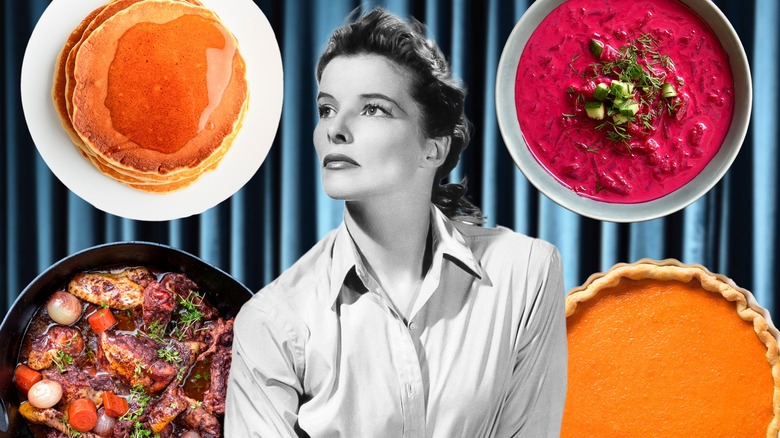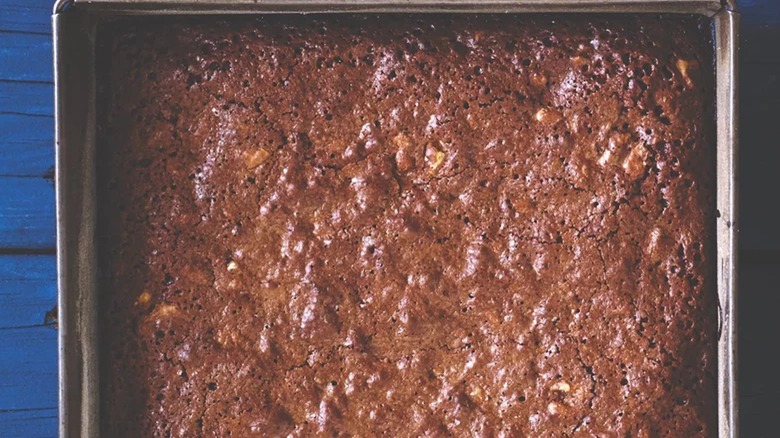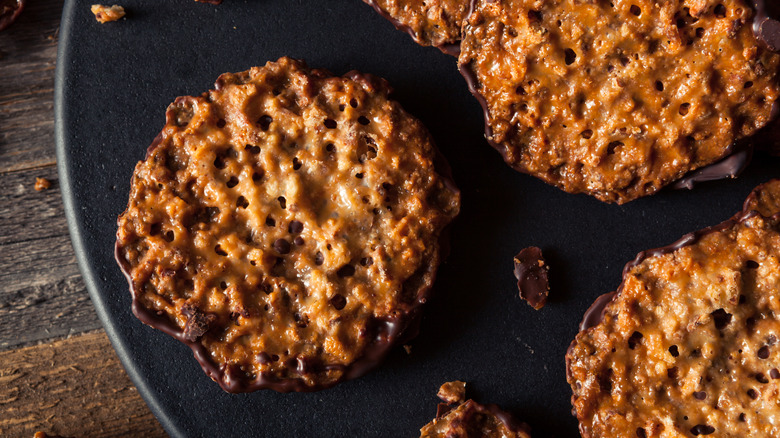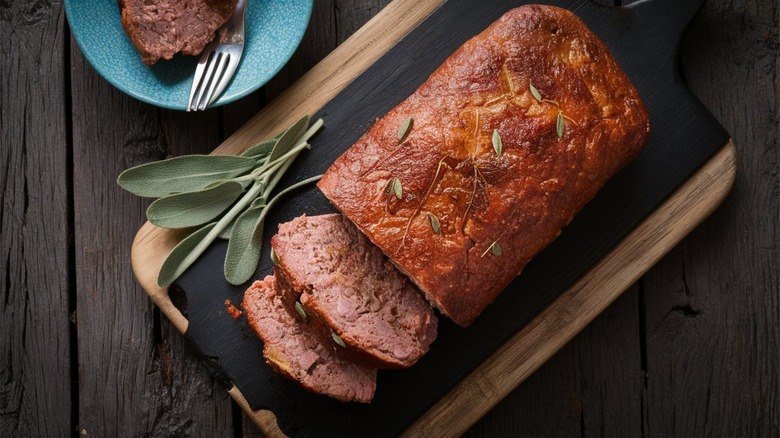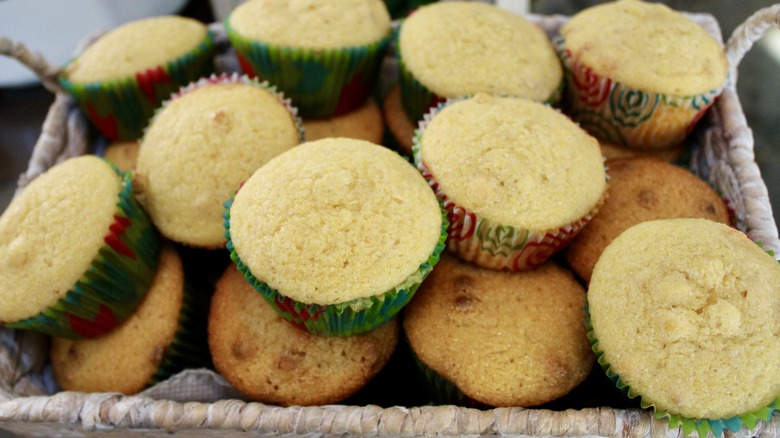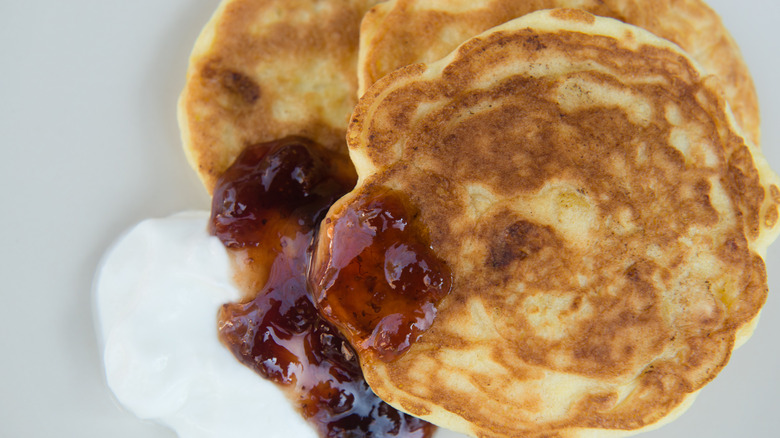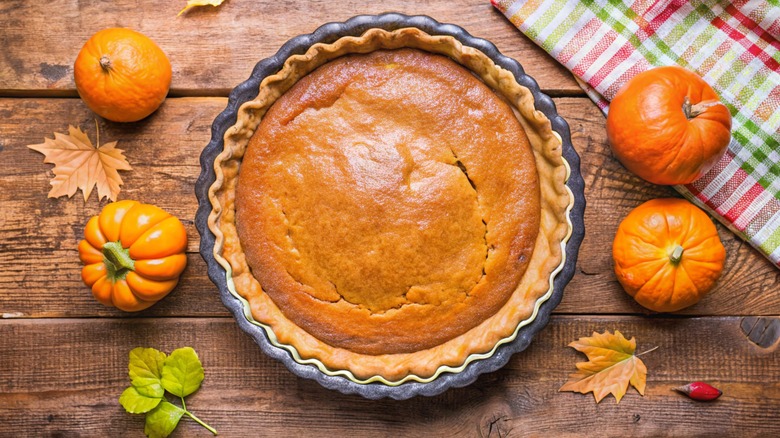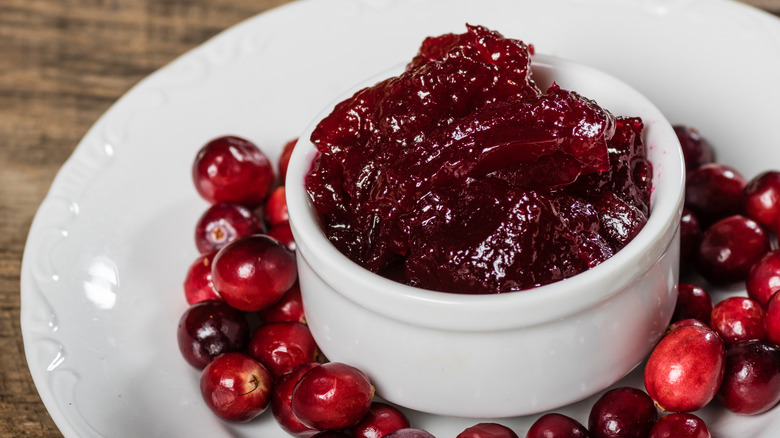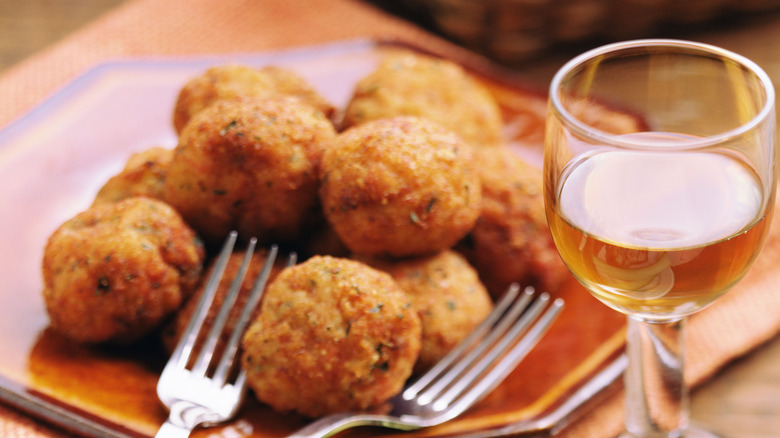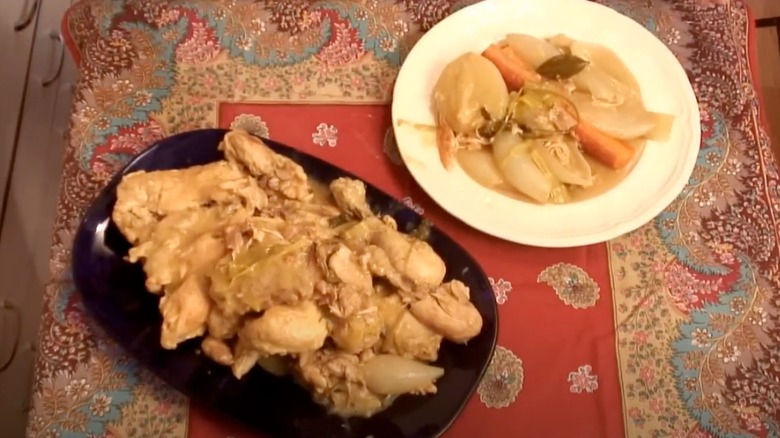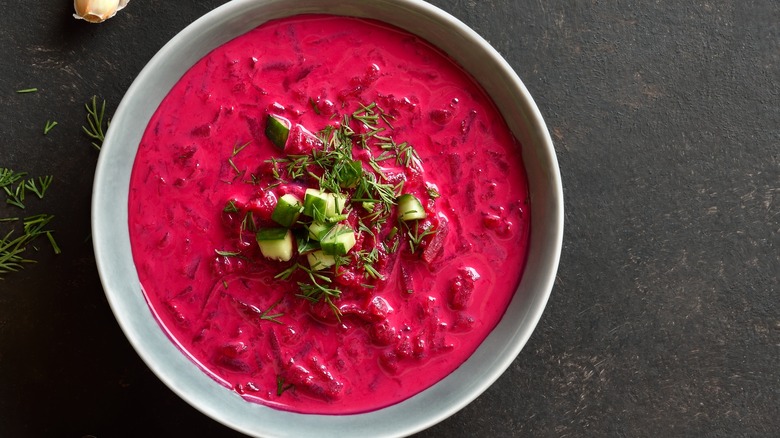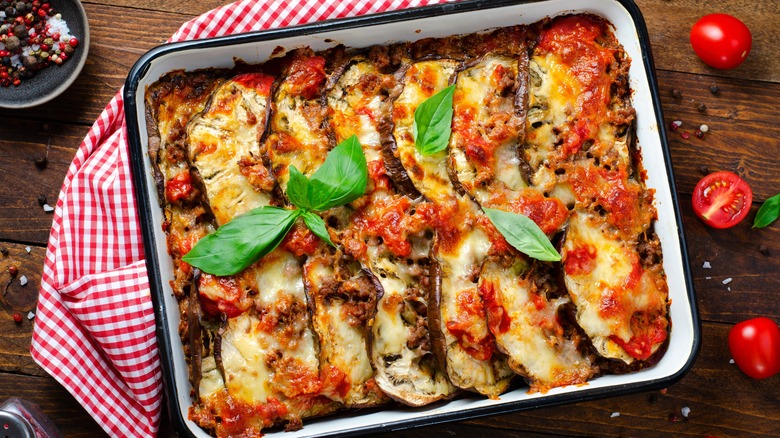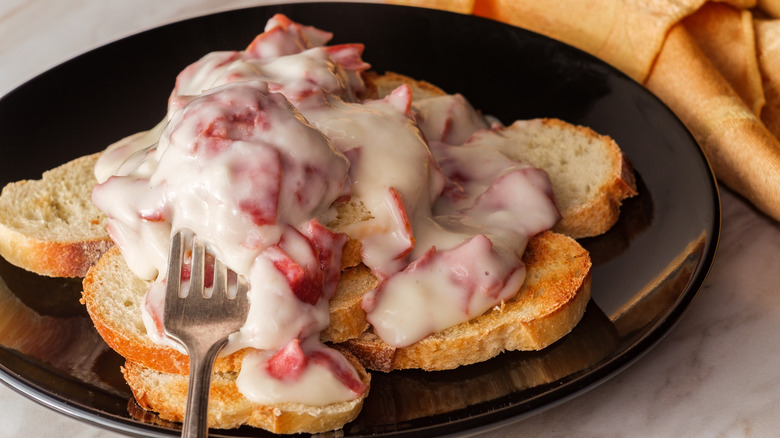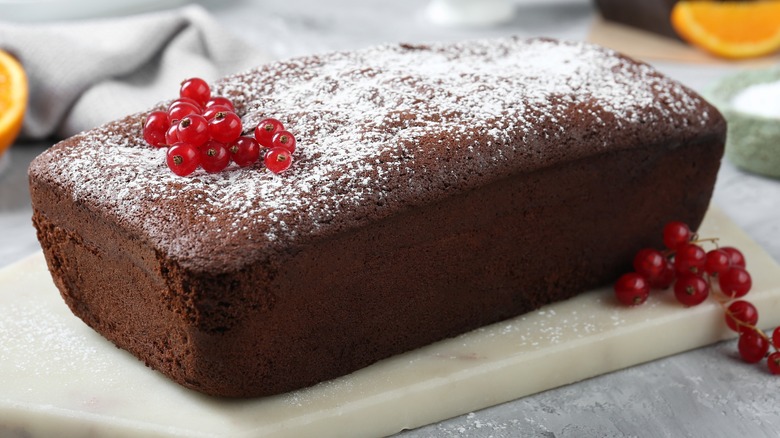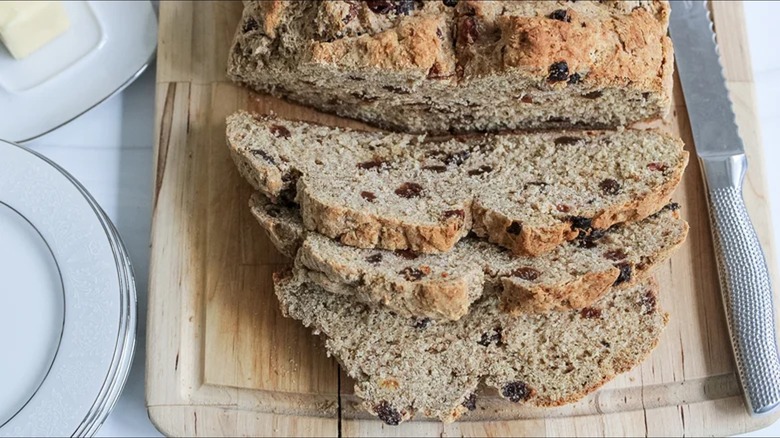14 Of Katharine Hepburn's Favorite Foods
Legendary actress Katharine Hepburn loved to entertain, and share her favorite foods with guests. Some of Hepburn's favorite food items have been shared with the press or included in celebrity cookbooks. But many of these were known to appear on repeat in her home, as well, and were often shared with her friends (who would occasionally make special requests when visiting).
Now, a number of dishes favored by Hepburn were prepared by her longtime personal cook and housekeeper, Norah Considine. Considine worked for the famous actress during the last three decades that Hepburn was alive, at her residence in Manhattan and her country home in Connecticut. Considine's daughter, Eileen Considine-Meara, wrote and published the book "At Home With Kate" that serves as a biography for Hepburn, as well as a snapshot of many of the foods enjoyed by the late, great Hepburn.
There are no shortage of foods known to be loved by Katharine Hepburn, including entrees, side dishes, and desserts. Hepburn believed desserts were a necessary part of every meal, after all, so we've included plenty of her favorite sweet dishes, as well. Though we weren't able to highlight every single food loved by Hepburn, we've still gathered an extensive list. Here are 14 of Katharine Hepburn's favorite foods.
Brownies
If you've previously heard about any of Katharine Hepburn's favorite foods, there's a good chance it was the Hollywood icon's famous brownie recipe. Many friends of Hepburn's likely ate some of her famed brownies while visiting her home because there always seemed to be some in the kitchen. In fact, her pals might have even gotten the chance to take some home.
Hepburn's famous brownies came from an old family recipe, and were known to be quite chocolatey, fudgy, and chewy without being cakey. She was careful not to overcook her brownies, as well, so they remained gooey and moist. Now, part of the trick is having the self-control to avoid cutting into a batch before they've cooled. Some versions of her recipe even suggest letting them cool in the fridge overnight (if you can resist them, that is).
The ingredients themselves are also important, though. If you handed Hepburn a cakey brownie, she'd likely be able to let you know what you'd done wrong — namely, adding too much flour. This makes sense, though, given the actress's recipe only includes ¼ cup of flour, along with a substantial amount of sugar, butter, chocolate, and nuts. At times, Hepburn may not have used any flour at all, which removed the risk they'd turn out too cake-like entirely.
Lace cookies
Lace cookies were a dessert that Katharine Hepburn's cook, Norah Considine, was known for making. The cookies were so popular with Hepburn and her guests that there were virtually always some fresh (or frozen) ones available whenever someone asked for them. Hepburn had such a strong love for this dessert that if there weren't any lace cookies in the kitchen when she got home from a trip, the four-time Academy Award winner was apt to prepare a batch herself.
Paper-thin lace cookies often made an appearance at afternoon teatime — served on antique teacups and saucers (not always matching) that Hepburn had collected during her world travels. The cookies had just a few ingredients: butter, egg, vanilla, white sugar, brown sugar, flour, and finely chopped walnuts. They were delicate, tasted like toffee, and were at the height of crispness 30 minutes or so after coming out of the oven. There was also a chocolate chip version of them, which Hepburn enjoyed, as well.
Fenwick meatloaf
The name of Fenwick meatloaf comes from Katharine Hepburn's waterfront home in the Fenwick section of Old Saybrook, Connecticut. The recipe for this particular meatloaf is one of many featured in the book "At Home with Kate" by Eileen Considine-Meara (daughter of Hepburn's longtime cook and housekeeper, Norah Considine) — leaving no doubt that Fenwick meatloaf was one the late actress's favorite foods.
Hepburn generally preferred to enjoy Fenwick meatloaf that was served hot from the oven. However, it wasn't uncommon for Considine to prepare a fresh meatloaf for Hepburn to take with her to her home in Fenwick if Considine was staying behind in New York.
Fenwick meatloaf starts with a pound each of ground beef, pork, and veal. To bulk it up, breadcrumbs, Parmesan cheese, and eggs were added, as well. It was seasoned with beef bouillon, garlic, onion, salt, pepper, along with other herbs and spices. While the recipe doesn't call for any sort of topping, it does mention making a horizontal cut in the loaf to place parsley before cooking.
Cornmeal muffins
A recipe for Katharine Hepburn's cornmeal muffins once showed up in a daily newspaper marketed to fans of Hollywood stars. It was shared in the 1930s, when Hepburn was acting in movies like "Little Women," "Stage Door," and "Bringing Up Baby." This particular muffin recipe contains both cornmeal and wheat flour, which makes it more muffin-like without so many crumbs. It also calls for molasses, which makes them slightly sweet — though Hepburn said you could substitute regular sugar instead.
In addition to those ingredients, the muffins contained ordinary corn muffin ingredients like baking powder, salt, milk, an egg, and melted butter. Hepburn liked to drizzle them with a little real maple syrup to ramp up the flavor and sweetness.
Now, some may suspect this recipe — for a supposed New England style of corn muffins — isn't authentic. But the fact that it calls for you to eat them hot and fresh from the oven makes us believe it was indeed Hepburn's own recipe. She often preferred to consume certain dishes immediately after they finished cooking, after all.
Pancakes
For Katharine Hepburn, pancakes weren't just for breakfast, but for lunch and snacking, too. We actually found two different pancake recipes attributed to Hepburn. One showed up in a Hartford, Connecticut newspaper in the 1940s, while the other was revealed by Hepburn's goddaughter and namesake, Katharine "Kat" Kramer.
Kramer enjoyed eating Katharine Hepburn's cottage cheese pancakes when the goddaughter and godmother visited each other. The bulk of these pancakes come from a cup of cottage cheese and trio of eggs, as only 4 tablespoons of whole wheat flour are included (along with some oil and salt). These pancakes are great with various toppings, as well, including applesauce, berries, honey, or butter. With fruit, it's more of a breakfast or dessert dish, but you could serve them for lunch with creamed meat or seafood on top.
Meanwhile, Hepburn's midnight snack pancakes contained pancake mix, sugar, milk, and egg, as well as chopped nuts and melted chocolate. What makes these especially special (besides the nuts and chocolate) is a sauce made of egg yolks, confectioner's sugar, vanilla, salt, and whipped cream. Just be sure you to plan ahead, so the sauce is cold in time to contrast well with the hot pancakes.
Pumpkin pie
In the mid-1930s, an unspecified newspaper published a pair of Katharine Hepburn's Thanksgiving recipes, including pumpkin pie. The no-nonsense Hepburn was a fan of making select holiday dishes the day before, as this removed a lot of stress on the day itself — particularly if she was hosting a large gathering for Thanksgiving dinner.
Now, at first glance, Hepburn's pumpkin pie recipe appears fairly ordinary. However, when you look at a classic pumpkin pie recipe, you'll notice a number of modern shortcuts weren't being taken by Hepburn in the 1930s. In fact, while we can just open up a can of pumpkin puree, the famous actress's recipe requires cooked pumpkin. Many modern pumpkin pie recipes also call for a can of sweetened condensed milk, while hers uses sugar and something called "rich milk."
While you can't find anything at the store labeled "rich milk" in the 2020s, any milk with a higher fat content than standard whole milk would qualify. Another feature of this recipe is that rather than just calling for pumpkin pie spice (and having to scour the internet looking for a pumpkin pie spice recipe), Hepburn included the exact spices needed: cinnamon, allspice, cloves, and ginger.
Cranberry conserve
Along with pumpkin pie, Katharine Hepburn also shared her Thanksgiving recipe for cranberry conserve in a newspaper in the mid-1930s. This side dish presents a different path for making homemade cranberry sauce – with a few twists you may not have seen before.
Hepburn's conserve contains cranberries, sugar, orange juice, and orange peels, which isn't too out of the ordinary for cranberry sauce. However, the special addition of chopped nuts and seedless raisins may appear unusual to 21st century diners. More than that, this may be the moment you stop and ponder the fact that raisins once came with seeds (and be grateful that they don't anymore).
Like her pumpkin pie, Hepburn suggested making this cranberry conserve before the holiday. The dish needs to chill in the fridge in a glass after it finishes, after all. Once chilled, remove and slice it into rounds like you would with cranberry sauce from a can.
Rice to the occasion
One of Katharine Hepburn's favorite foods was what she referred to as "rice to the occasion," as it was called in a 1930s newspaper. This dish was essentially a fried rice and shrimp ball filled with other interesting ingredients. In fact, while we've seen several fried shrimp and rice ball recipes, and shrimp and rice croquette recipes, none are quite like this favorite food of Hepburn's.
The rice balls in this recipe contain a mixture of cooked rice, minced onions, eggs, chopped canned shrimp, chopped green pepper, chopped celery, salt, and pepper. The proportions are quite curious, as well, with Hepburn using three large onions and a dozen eggs for a mere 2 cups of rice.
The instructions call for mixing everything together until your arm feels like it's going to fall off, which helps the eggs become more cohesive with the rice and other ingredients. The tablespoons-sized balls were also browned in bacon grease, which adds to the overall flavor profile.
Chicken Burgundy style
One of Katharine Hepburn's more famous recipes — and one of her favorite foods, as well — was her chicken Burgundy style. The recipe was first published in 1940, in a fundraiser cookbook called "Specialites de la Maison" in support of The American Friends of France (a charity started by J.P. Morgan's daughter). The cookbook initially raised money for people in France needing medical assistance from wounds sustained during World War II, and was republished in 2010 when someone ran across it (and realized its historical value).
Hepburn's chicken Burgundy style starts off with floured and butter-fried chicken simmered in broth with carrots, leeks, and celery. It's then seasoned with garlic, cloves, parsley and a bay leaf, before it gets something like a French mousseline sauce mixed in, with egg yolks, heavy cream, and lemon juice. The topping for this chicken sounds a little unusual, as well, but was clearly enjoyed by Hepburn: sliced mushrooms and sliced sour pickles (like cornichons).
Cold beet soup
Katharine Hepburn loved soup, and cold beet soup was her favorite kind. Jars of this soup were always stored in the fridge, making it easy to grab on the way out the door if the actress decided to head up to her house in Connecticut with some food. Hepburn also enjoyed this soup (and others) in a specific way at times: in a coffee cup with a handle (rather than in a bowl) so she could easily sip it without a spoon.
Since it was generally on hand and available, Hepburn often offered cold beet soup to guests. She once served it to a journalist interviewing here for the Los Angeles Tribune, and to Michael Jackson when he visited her for dinner. In fact, as noted in the book, "Kate Remembered" by A. Scott Berg, the late singer accidentally spooned a dollop of butter instead of sour cream into his soup. Jackson insisted on eating it, though, even after Hepburn offered him a fresh bowl.
Now, while cold beet soup was clearly a favorite food of Hepburn's, you unfortunately won't be able to recreate the exact same dish in the 21st century. A key ingredient mentioned in the recipe is a 33-ounce bottle of "Mother's borscht," after all. It's impossible to know whether that refers to a brand name or a bottle of Norah Considine's own borscht, so you'll have to settle for a close approximation to Hepburn's favorite soup.
Eggplant in casserole
In the 1930s, a cookbook featuring Katharine Hepburn's recipe for a dish called eggplant in casserole was released to the public. Available for $1 at the time, "Milady's Style Parade and Recipe Book for 1935" mainly offered recipes created by famous chefs around the U.S., alongside generic pictures of 1930s Hollywood stars. Of course, since Hepburn was actually pictured with her eggplant in casserole dish in the book, it seems likely that she actually enjoyed it (rather than it being a random dish with no association to her).
The supposed recipe for Hepburn's eggplant in casserole is somewhat simple compared to other eggplant dishes we've seen. Then again, the recipes we were able to find may be more of a modern adaptation of Hepburn's own dish (given the mention of Pam cooking spray, which wasn't invented until the 1950s). Either way, the recipe likely involved adding multiple layers of fried eggplant, homemade tomato sauce (made with sauteed tomatoes, onions, and parsley), and breadcrumbs to a greased casserole dish before baking. It sounds simple, but we bet it's good.
Creamed chipped beef on toast
While creamed chipped beef on toast is one of many old fashioned snacks that are great for parties, most of us have presumably forgotten the option exists. While the dish isn't much for looks, it was one of many crowd-pleasing dishes that Katharine Hepburn often served to her guests, with actor Jack Larson known to ask for it when he visited.
Creamed chipped beef on toast seems to have first showed up in the "Manual of Army Cooks" in 1910. The dish worked well as mobile military food when World War I came around seven years later, since it uses shelf-stable ingredients like a dried meat product called chipped beef, fat, evaporated milk, beef stock, pepper, and parsley. It was also an economical dish to make in the Depression era, and helped feed U.S. soldiers during World War II.
Interestingly, the version of the dish that Hepburn's cook, Norah Considine, prepared for guests was similar to one the made by the military. However, her version omitted beef stock, and included sage instead of parsley.
Currant cake
In 1978, when Katharine Hepburn was 72, she visited Wales to shoot the film "The Corn is Green." When the film crew found a particularly picturesque Welsh farm, Hepburn knocked on the door herself to make introductions and ask permission to film there. The Hughes family, who owned the farm, welcomed them. While the movie was on location at their farm, the family often brought out coffee, tea, and currant cake to those involved with the film. Consequently, Hepburn became besotted with the cake.
The recipe for this currant cake shows up in Hepburn's autobiography, "Me: Stories of My Life," published in 1996. It's fairly simple, featuring self-rising flour, margarine, white and brown sugar, eggs, milk, and currants — with the currants playing a genuinely big part in the cake. Additionally, it's sprinkled with brown sugar for added texture and sweetness on top, which presumably furthered Hepburn's enjoyment of this cake.
Irish soda bread
Norah Considine cooked several dishes that reflected her Irish heritage, including another of Katharine Hepburn's favorite foods: Irish soda bread. Now, while technically called "bread," this Irish soda bread recipe is more like a cake. It's sweet, and has a texture somewhere between cake and cornbread (with a thicker crumb than cake).
Additionally, unlike normal bread, it uses baking soda to get it to rise instead of yeast. The trick to getting baked goods to rise with baking soda is to also include an acidic ingredient to activate the baking soda. Considine actually used her cousin's Irish soda bread recipe, which called for baking powder, despite also including acidic sour cream. Oddly enough, it included baking soda, as well, so there were two leavening ingredients at work.
A single cup of sugar made this Irish soda bread sweeter like cake, too. Adding butter and eggs to the flour also put it squarely into cake territory rather than bread. However, since the dough was firm instead of soupy (like cake batter), it was molded into a pan and resembled bread more than cake — thus, its name.
